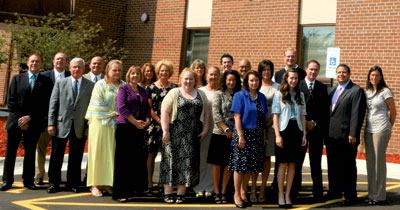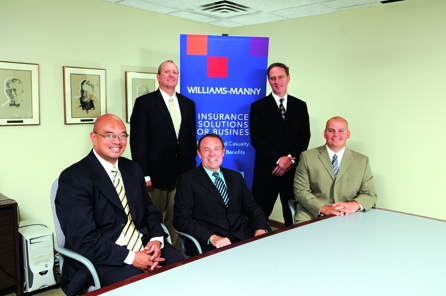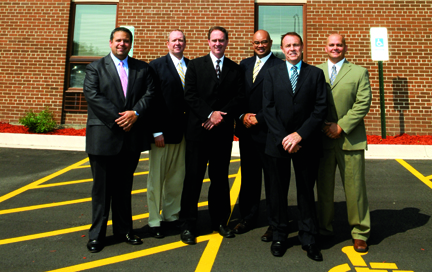 |
 |
 |
Capitalizing on benefits Sophisticated service & acquisitions drive benefits growth In eight years Williams-Manny's benefits revenues rise from 25% to45% of total revenues
By Len Strazewski The industrial boom of the 1950s turned into the Rust Belt of the 1970s and 1980s. Shuttered manufacturing plants and employee layoffs turned Rockford, Illinois, the state's second largest city, into a struggling step-sister of Chicago. But today, the Rockford economy is on its way back, says Dan Ross, president of Williams-Manny, Inc., the largest independent agency in Northern Illinois. And with every small to medium-sized employer rebuilding its workforce, the agency is adding to its thriving employee benefits portfolio. Founded in 1896, the agency has been a cornerstone of the region, Ross notes, and its executives have seen the local economy evolve through negative and positive changes. At the same time, the agency itself evolved.
"Like many independent agencies, we started as a property/casualty insurance specialist, providing business coverage to industrial companies in our area. But as clients' need for employee benefits and related services grew, so did we, adding employee benefits expertise and other services," he says. The agency began providing employee benefits services more than 25 years ago and by 2005, Williams-Manny had two benefits producers, generating about 25% of agency revenues. But Ross says executives saw growing opportunity to cross-sell its client base as well as win the business of other employers with sophisticated needs. In 2007, the firm merged with Midwest Life and Health Group, an employee benefits specialist agency, and the business began to skyrocket, Ross says.
Today, employee benefits accounts for about 45% of agency revenues, and Ross says continued growth and acquisitions could easily pull benefits up equal to property/casualty sales. The agency plans to acquire as many as five smaller agencies within the next five years. The agency now has 86 employees, about 25 of whom specialize in employee benefits. The agency has offices in Rockford and Freeport, Illinois. Ross says the firm specializes in employers with 50 to 500 employees, but he notes that its growing reputation is attracting larger companies to the fold, as big as 3,500 employees. Timothy Knauf, president of the employee benefits division, agrees that the region is on the rise, creating a demand for more comprehensive employment-related services. Knauf and Ray Rice, vice president of employee benefits, joined the agency in 2007 when Midwest Life and Health Group merged with Williams-Manny. "Like our customers, we are constantly evolving and looking for a way to improve our business process. We are always adding new management and technology tools and developing improved strategies for delivering our services," Knauf says. He points out that the benefits division takes a sophisticated risk management approach to benefits management, analyzing employer demographics and competitive position as well as employer goals for plan design and cost control. Prospective clients are given a welcome tour of the agency and presented with a "dashboard" proposal that summarizes the agency capabilities in a few pages but provides greater details for executives who need them. When an employer commits to a multi-year agency of record agreement, the benefits specialists prepare a five-year strategic vision plan designed to meet their goals. They supplement the plan annually with a stewardship report that details the services provided by the agency and the progress toward the strategic goals. "Communication, knowledge and responsiveness—those are our top differentiators," Knauf says. Ray Rice agrees that in in the past few years, the agency has become more of a consultant and adviser than a broker and, as a result, has begun to explore fee-based compensation that reflects the enhanced value the firm provides. "Commission-based compensation is fast becoming inappropriate for many of us. Commissions increase when costs increase, and in most cases, our goal is to reduce costs. It is much more appropriate to compensate with fees that reflect performance and the range of special services that we provide." Cost control is the most critical continuing issue for employers, the benefits division leaders say. But the agency responds to other employer challenges as well, including compliance and regulatory management, human resources services and wellness and health management.
The new health care reform regulations have many employers puzzled about the choices and responsibilities required by the new law. As a result, the agency schedules regular in-house training sessions and Webinars conducted by a Certified Health Care Reform Specialist, Knauf says. The education programs, scheduled two to three times a month, regularly attract 30 to 40 present and prospective clients. The agency is also a member of United Benefit Advisors (UBA), a member-owned alliance of more than 140 employee benefits advisory firms with more than 165 offices. UBA provides newsletters and e-mail communications on general employee benefits news, compliance issues and human resources management strategy as well as project consulting. To provide human resources support, Williams-Manny hosts the UBA Web portal HRInsider and also subscribes to ThinkHR, a human resources consulting call center in Pleasanton, California. Rice notes that sophisticated service has become an important differentiator in the agency approach to employee benefits management. "Human resources staffs have become so overworked that they rely on their agency to fill in for them in administrative functions. We generally handle all annual enrollment, COBRA administration and voluntary benefits administration," he says. The agency provides Web-based tools to its clients to facilitate enrollment and ongoing benefits communication, and most recently purchased a mobile benefits management app that can be used by employees and dependents to enroll in and manage benefits by iPad or smartphone access. In addition, the agency operates a licensed third-party administrator that provides claims and financial management services, notably Health Reimbursement Account management, to more than 60 employer groups. It has also developed a specialty in municipalities and local government risks, providing benefits advice and service, and is in the initial stages of providing cooperative purchasing to cities, towns and counties in Northern Illinois. Through these joint purchasing agreements, the agency will be able to reduce costs for participants and improve services, Rice says. Wellness and health management is also in growing demand, and the agency plans to hire an in-house wellness consultant next year to expand upon wellness and health incentives programs provided by the health insurers. Despite the explosion of new services, the agency continues to play a traditional brokerage role for many employers. The agency markets traditional health insurance benefits, including group life insurance, dental insurance, short- and long-term disability insurance and long-term care insurance, as well as employee-paid voluntary benefits. The agency provides retirement plan consulting through a strategic partnership but does not have a retirement benefits division. Benefits Analyst Susanne Dalton is the agency's supervisor of insurance markets, maintaining close relations with health plans that compete in the area. She supervises preparation of annual renewal presentations, reviews claims data, and helps connect benefits clients with the various services provided directly by the insurers. She says the Rockford region has fewer health plans actively competing than it had several years ago, but still has a strong market. The agency works with more than 30 benefits providers, including more than eight group medical insurers. BlueCross BlueShield of Illinois is the state leader, the largest provider in the state, but Dalton says the region still has several health plans regularly competing for local employers and their benefits business, including large national carriers such as Humana and Coventry Health, recently acquired by national leader Aetna Health. Each of the health plans offers diverse services to employers, including administrative services-only agreements for employers who seek to self-fund some benefits, wellness and health incentives programs, and innovative plan designs that can help companies meet their cost objectives, Dalton says. However, some employers have been reluctant to commit to some of the new plan designs that are available. "Health Savings Accounts haven't performed as well as we had hoped among our employers," she says. "It is sometimes difficult to get groups to look at HSAs to include in their benefit options. We are still working hard to educate employers about how they work and how they can both reduce costs and provide tax savings to their employees." Health plans, however, are becoming more creative with their plan designs, she notes, and at least one carrier has begun providing hybrid designs that provide some savings account features in a standard Preferred Provider Organization plan design. Michael Parsons, director of large group services, works with employers that self-fund employee benefits. Most are large companies, but some are relatively small with as few as 100 employees. "Size isn't necessarily the determining factor," he explains. "They must have an appetite for risk, cash flow and willingness to be committed to the plan management. "There are special challenges that come with self-funding of benefits for large groups," Parsons continues. "There are plenty of benefits, including release from state insurance mandates and a better ability to control costs. But you must manage your plan and stay interested in your plan performance. Employers that self-fund are really taking on a lot. " Claims monitoring is essential, he says, and employers must make sure they understand the impact of those claims and make appropriate adjustments. Some of the decisions may not immediately reduce costs. "If you have an unusual increase in utilization, you may actually have to increase your budget." The author Len Strazewski is a Chicago-based writer, editor and educator specializing in marketing, management and technology topics. In addition to contributing to Rough Notes, he has written on insurance for Business Insurance, Risk & Insurance, the Chicago Tribune and Human Resource Executive, among other publications.
|
||||||||||
| ||||||||||
| ©The Rough Notes Company. No part of this publication may be reproduced, translated, stored in a database or retrieval system, or transmitted in any form by electronic, mechanical, photocopying, recording, or by other means, except as expressly permitted by the publisher. For permission contact Samuel W. Berman. |



